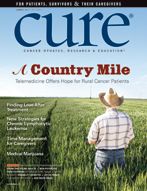Publication
Article
CURE
Keeping the World in World-Class Cancer Care
Author(s):
A cancer diagnosis can be perceived as a demarcation line, dividing life into a "before" period filled with all that's familiar and an "after" period clouded by the murky unknown.
A cancer diagnosis can be perceived as a demarcation line, dividing life into a “before” period filled with all that’s familiar and an “after” period clouded by the murky unknown.
For many, the diagnosis sparks fear and a drive to ease it by gathering information — facts about the type of cancer in question, the prognoses that can be associated with it, the treatments available either on the market or in clinical trials, and insights about how best to bear up while dealing with the emotions and other physical and lifestyle implications that can accompany an illness.
CURE’s mission has always been to offer hope by providing those answers. Through the perspectives of experts -- from oncologists to advocacy group leaders to patients -- we bring you in-depth information about a host of cancer types and the most advanced thought about their treatment, insights about how and in whom those treatments may best be applied, tools for decisionmaking and a broad sampling of the kinds of medical and psychosocial support mechanisms that are available to patients and their loved ones.
In the summer issue of CURE, we emphasize our dedication to spreading that knowledge to every corner of the globe with a cover story about people with cancer who live in rural areas of the United States. These patients tend to live further from expert oncologic care while also experiencing lifestyle issues that can get in the way of treatment. Our article offers strategies to help rural Americans access the world-class cancer care and psychosocial help they deserve, with a focus on one technique in particular: telemedicine.
Another article sheds light on the growth and evolution of hospital-based programs for teens and young adults who have cancer. We think it’s vital for readers affected by teenage cancer -- before they choose treatment facilities -- to know about and consider such programs, which often include a specialized health care team and housing within a cancer center, aimed at supporting patients with the peer interaction, activities and counseling they need at their stage in life.
In addition, we offer two medical features — one detailing recent advances in the treatment of chronic lymphocytic leukemia, which have reverberated through the oncology world, and the other on medical marijuana and whether it can help patients with cancer to ease pain and nausea or increase appetite.
We also continue our commitment to sharing potentially paradigm-changing research by summarizing top stories from the annual meeting of the American Society of Clinical Oncology, as well as the most recent approvals of cancer drugs by the U.S. Food and Drug Administration.
We hope this issue of CURE highlights information you won’t find anywhere else, along with strategies and personal stories that will provide you with hope and inspiration as you navigate your cancer journey — no matter where you are. As always, thank you for reading.






